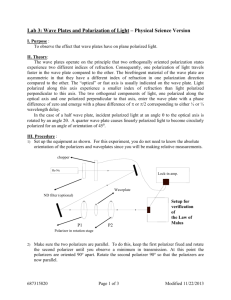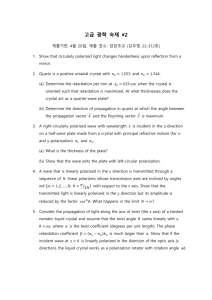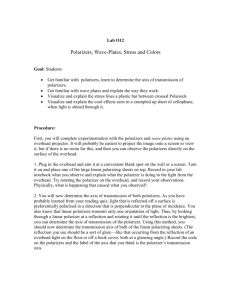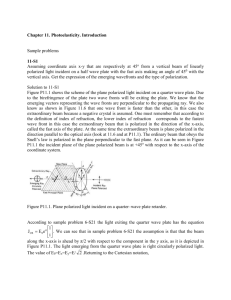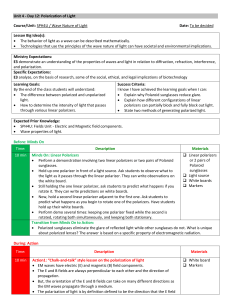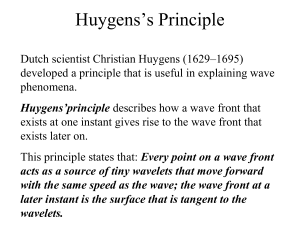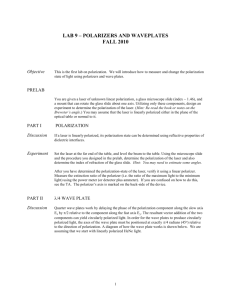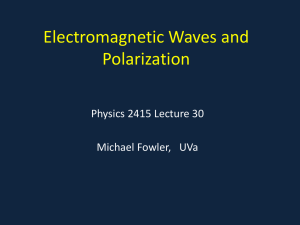Word 97 Format
advertisement
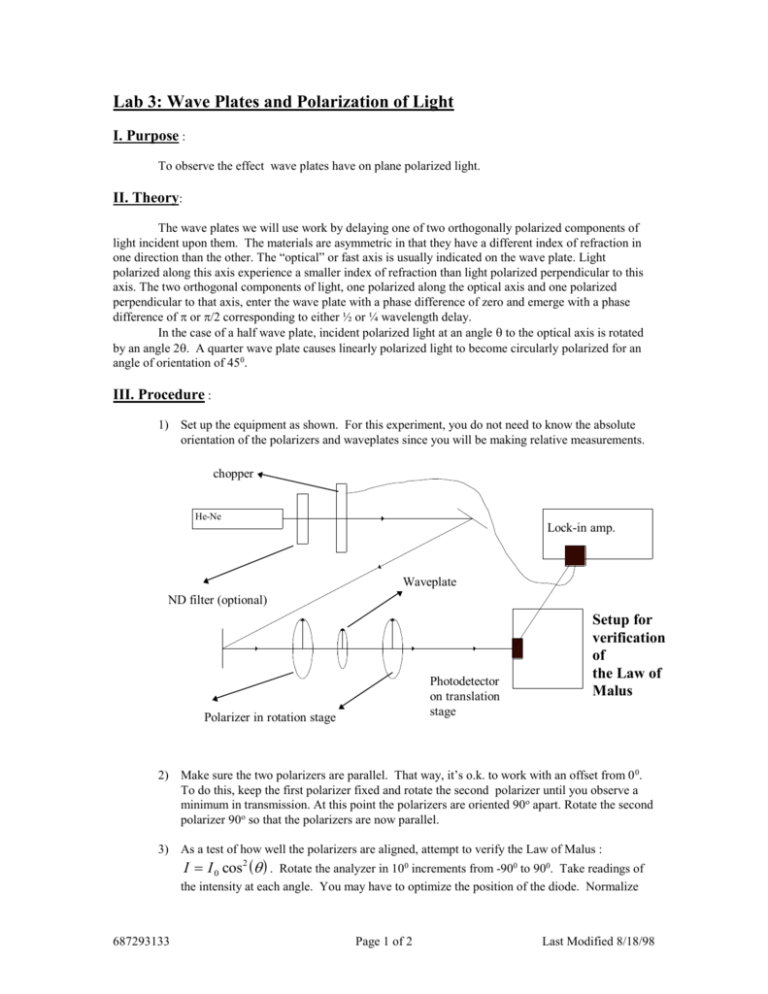
Lab 3: Wave Plates and Polarization of Light I. Purpose : To observe the effect wave plates have on plane polarized light. II. Theory: The wave plates we will use work by delaying one of two orthogonally polarized components of light incident upon them. The materials are asymmetric in that they have a different index of refraction in one direction than the other. The “optical” or fast axis is usually indicated on the wave plate. Light polarized along this axis experience a smaller index of refraction than light polarized perpendicular to this axis. The two orthogonal components of light, one polarized along the optical axis and one polarized perpendicular to that axis, enter the wave plate with a phase difference of zero and emerge with a phase difference of or /2 corresponding to either ½ or ¼ wavelength delay. In the case of a half wave plate, incident polarized light at an angle to the optical axis is rotated by an angle 2. A quarter wave plate causes linearly polarized light to become circularly polarized for an angle of orientation of 450. III. Procedure : 1) Set up the equipment as shown. For this experiment, you do not need to know the absolute orientation of the polarizers and waveplates since you will be making relative measurements. chopper He-Ne Lock-in amp. Waveplate ND filter (optional) Photodetector on translation stage Polarizer in rotation stage Setup for verification of the Law of Malus 2) Make sure the two polarizers are parallel. That way, it’s o.k. to work with an offset from 0 0. To do this, keep the first polarizer fixed and rotate the second polarizer until you observe a minimum in transmission. At this point the polarizers are oriented 90o apart. Rotate the second polarizer 90o so that the polarizers are now parallel. 3) As a test of how well the polarizers are aligned, attempt to verify the Law of Malus : I I 0 cos2 . Rotate the analyzer in 100 increments from -900 to 900. Take readings of the intensity at each angle. You may have to optimize the position of the diode. Normalize 687293133 Page 1 of 2 Last Modified 8/18/98 your data. If your data matches the theoretical curve, then the polarizers are aligned. If not, repeat steps one and two. In your lab report, plot the theoretical curve and experimental curve on the same graph. 4) Place the half wave plate in the 1” rotation stage and put it in between the polarizers. To check alignment, let both polarizers stay at 00 and rotate the half wave plate until you see a minimum in intensity. This corresponds to the half wave plate making an angle of 45 o with respect to the polarizers. Rotate the wave plate 45o. This position corresponds to 0o orientation of the waveplate. In general, you will have to work with an offset from the scale on the rotation scale. Repeat step 3 for 0, 20, 45 and 90 degrees of orientation for the half wave plate. In your lab report, plot your experimental and theoretical data on the same graph. How well does theory correspond to experiment? 5) Repeat step 3 for the quarter wave plate using 00, 200, and 450 for the rotation of the 1/4 wave plate. Compare your results with the theoretical data. Plot both the theory and experimental results on the same graph. How well does theory correspond to experiment. EXPLAIN YOUR RESULTS. For the theoretical curve, the normalized detected power is given by (see Figure 2 for definition of angles): P cos 2 cos cos sin sin Po sin 2 2 cos sin cos sin 2 The derivation of this equation will be covered in class. IV. Discussion: 1) Knowing that a mirror reverses the “handedness” of circularly polarized light, describe a how the following optical components act as an `optical diode’. In other words the light reflected by mirror M1 does not pass through polarizer P1. 2) The waveplates are designed to work at normal incidence. If the light incident upon a waveplate were not normal to the surface, how would the polarization and direction of the E and O waves emerging from the plate be affected? (See Hecht). 687293133 Page 2 of 2 Last Modified 8/18/98
